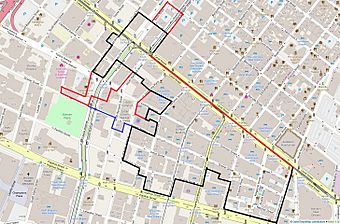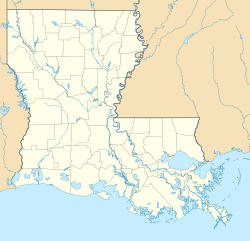New Orleans Lower Central Business District facts for kids
|
New Orleans Lower Central Business District
|
|

Lower Central Business District with original (black) increase I (red) and increase II (blue) boundaries
|
|
| Lua error in Module:Location_map at line 420: attempt to index field 'wikibase' (a nil value). | |
| Location | Roughly bounded by Canal, Tchoupitoulas, Poydras, O'Keefe, Common and S. Saratoga, New Orleans, Louisiana |
|---|---|
| Area | 72 acres (29 ha) (original) |
| Built | 1830 - 1941 (original) |
| Architect | Multiple |
| Architectural style | Classical Revival, Greek Revival, Italianate |
| NRHP reference No. | 91000825 (original) 06000110 (increase) |
Quick facts for kids Significant dates |
|
| Added to NRHP | June 24, 1991 |
| Boundary increase | February 9, 2006 |
|
New Orleans Lower Central Business District (Boundary Increase)
|
|
| Location | Approx. Rampart, Tulane, Loyola, Gravier, O'Keefe and Common, New Orleans, Louisiana |
|---|---|
| Area | 5 acres (2.0 ha) |
| Architect | Benson, Reihl; Goldstein, Parham, Labouisse et. al. |
| Architectural style | International Style |
| NRHP reference No. | 06000110 |
| Added to NRHP | February 9, 2006 |
The New Orleans Lower Central Business District is a special area in New Orleans, Louisiana. It's like a protected neighborhood because of its important history. This district was added to the National Register of Historic Places in 1991. People sometimes just call it the Lower Central Business District.
It's part of a bigger area called the New Orleans Central Business District. To the north, it's right next to the famous French Quarter, which is also a very old and important place.
Contents
What is a Historic District?
A historic district is a special area that has many old buildings or places that are important to history. These districts are protected to help keep their unique look and story alive. The Lower Central Business District is one of these special places.
When it was first listed in 1991, the district covered about 72 acres (29 hectares). It included 251 buildings that were considered important to its history. These buildings were built between 1830 and 1941.
Architectural Styles You Can See
The buildings in this district show off several cool architectural styles. You can see:
- Classical Revival: This style looks back to ancient Greek and Roman designs. Buildings often have grand columns and balanced shapes.
- Greek Revival: This is similar to Classical Revival but focuses more on the simple, strong look of ancient Greek temples.
- Italianate: This style was popular in the mid-1800s. Buildings often have tall, narrow windows, wide eaves, and decorative brackets.
Most of the buildings in the Lower Central Business District are for businesses. They are shops, offices, and other commercial places.
Famous Buildings in the District
While most buildings are for businesses, there was once a famous home here. The only house still standing in the district was at 824 Canal Street. It was built in 1844 for Dr. William Newton Mercer.
Later, in 1884, this house became the Boston Club. This was a private club for men. It's an interesting example of how buildings can change their use over time.
Many buildings in the district are so important that they are listed separately on the National Register of Historic Places. Some of these include:
- The Hennen Building (built 1894–95) at 203 Carondelet Street.
- The New Orleans Cotton Exchange Building (built 1921) at 231 Carondelet Street.
- The National American Bank Building (built 1929) at 200 Carondelet Street.
- The beautiful Orpheum Theatre (built 1918) at 125-129 University Place.
- The Macheca Building (built 1901) at 828 Canal Street.
How the District Grew
Over time, the boundaries of the historic district have been updated. In 2006, the district was expanded. This added about 5 more acres (2 hectares) to the protected area.
This expansion included nine more buildings that were important to the district's history. One of these was the New Orleans Public Library. Another building, the Joy Theater (built in 1946), was also added as a contributing building.
The buildings added in 2006 included examples of the International Style of architecture. This style is known for its clean lines, glass, and steel, often looking very modern. Some of these buildings were built as late as 1956.
Images for kids




